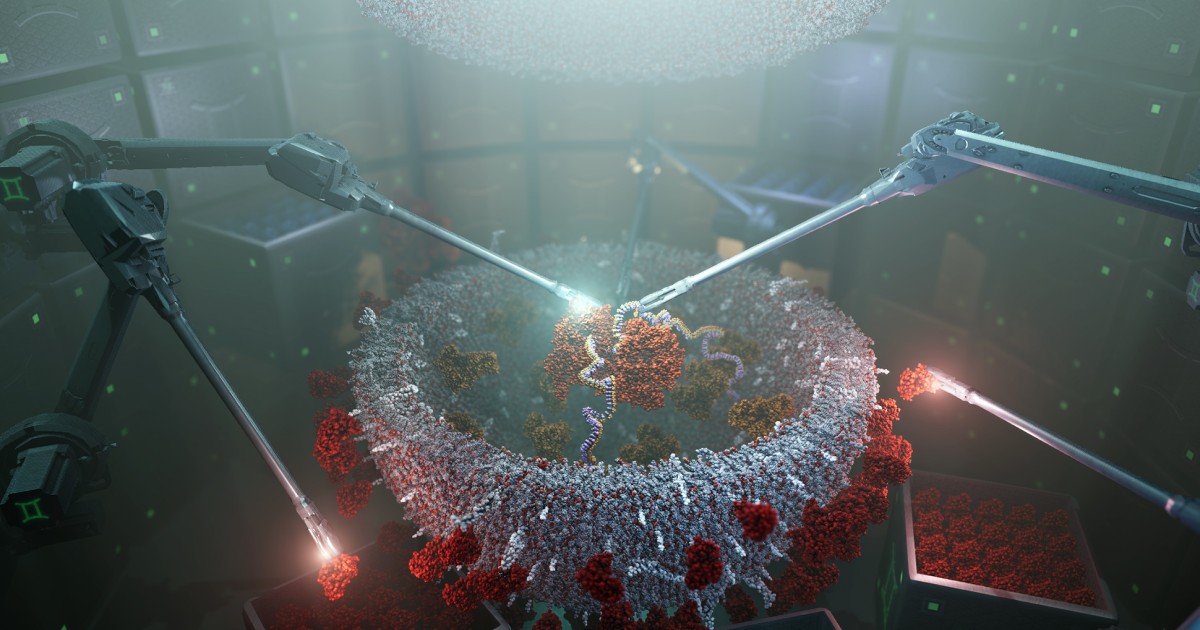
“Viruses have a natural ability to enter cells and deliver cargo,” Leonard said. “Borrowing viral parts is an effective strategy for achieving delivery, but then you are somewhat limited to the types of delivery that the virus evolved to do. It takes substantial engineering work to tweak those systems to alter their functions for each application. In this story, we instead attempted to mimic the strategy that viruses have evolved, but we used new biological ‘parts’ to overcome some limitations of viral vectors and ultimately make new functionalities possible.”
To design a multifunctional vehicle, the researchers looked to EVs, which Leonard described as “a blank slate.” In all living beings (from yeast to plants to humans), cells naturally shed EVs, which researchers think play an important role in communication among cells and natural processes such as immune function.
“These particles are being shed and taken up by cells all the time — in both healthy and disease processes,” Leonard said. “For example, we know that cancer cells shed EVs, and that seems to be a part of the process by which cancer spreads from one site to another. On the flip side, EVs also transfer samples of invading pathogens from infected cells to immune cells, helping the body marshal an effective response.”
Harnessing a ‘blank slate’
For Leonard’s EV-based platform, his team developed and synthesized custom DNA molecules that were introduced into a producer cell. The DNA provided instructions for the producer cell to produce new biomolecules and then load those molecules onto the surface and inside the interior of EVs. This effectively generated EVs adorned with specifically designed characteristics — and cargo already in tow.
“We treat the EVs produced by cells as essentially blank slates upon which we can compose new functions by engineering those producer cells to express engineered or natural proteins and nucleic acids,” Leonard said. “These alter the EV function and can comprise bioactive, therapeutic cargo.”
To be successful, the EVs must target the correct cells, transfer their cargo into those cells and avoid side effects — all while avoiding the patient’s always vigilant immune system. Compared to viruses, EVs are likely more capable of evading rejection by the immune system. Because EVs can be produced with materials largely found in a patient’s own cells, the body is less likely to treat the particles as a foreign substance.
The T cell challenge
To test the concept, Leonard and his team looked to an attractive yet stubborn target: T cells. Because T cells naturally help the body fight germs and disease, researchers have looked to enhance T cells’ natural abilities for immunotherapy applications.
“Most cells are constantly sampling little bits of their environment,” said the study’s lead author Devin Stranford, a graduate from Leonard’s lab and now a scientist at Syenex. “But, for whatever reason, T cells don’t do that as much. Therefore, it’s challenging to deliver drugs to T cells because they won’t actively take them up. You have to get the biology right in order for those delivery events to occur.”
In the experiments, the researchers engineered a producer cell to generate EVs loaded with Cas9, a protein that is part of the CRISPR system, paired with an engineered RNA molecule to direct it to recognize and alter a specific sequence of DNA in a cell’s genome. The researchers introduced the modified EVs into a culture of T cells. The EVs efficiently bound to the T cells and successfully delivered their cargo, leading to a genetic edit that inactivated the gene encoding a receptor used by HIV to infect T cells. Although treatment of HIV infections was not an immediate goal of this project, this work nonetheless illustrates that promise, demonstrating the types of new therapeutic functions that the technology enables.
“A key goal of this work was using rigorous methods to ensure that the cargo got all the way to where it needed to go,” Leonard said. “Because we’re making edits to the genome of these cells, we can use powerful technologies like next-generation sequencing to confirm that those exact edits were present in the recipient cells, in the location of the genome where they were intended.”
What’s next?
Called GEMINI (Genetically Encoded Multifunctional Integrated Nanovesicles), the new platform represents a suite of technologies for genetically engineering cells to produce multifunctional EVs to address diverse patient needs.
“Depending on the treatment, one might need a billion EVs,” he said. “But because they are so small, it’s actually a tiny amount of material. Others have already demonstrated that EVs can be produced in clinically translatable ways at commercial scale. Indeed, a particular benefit of biologically encoding EV functions, as we have, is that all the complexity goes into engineering the DNA programs. Once that is done, such processes are readily compatible with mature, existing manufacturing methods.”
Through Syenex, Leonard hopes to use the GEMINI platform, alongside other synthetic biology technologies, to rapidly generate best-in-case delivery vehicles that enable developers — ranging from academic spinouts to mature biotechnology companies — to design new, life-changing cell and gene therapies.
“By demonstrating the ability to genetically encode cargo and surface compositions of nanovesicles with the GEMINI platform, we can turn a hard biology problem into an easier DNA engineering problem,” Leonard said. “That enables us to tap into the ongoing exponential improvements in DNA synthesis and sequencing that have powered the growth of synthetic biology. We are optimistic that these approaches will enable researchers to solve the big delivery challenges and develop new and improved treatments that benefit a wide range of patients.”
Editor’s note: Joshua Leonard has financial interests in and affiliations with Syenex, Inc. Northwestern University has financial interests (equities, royalties) in Syenex, Inc.